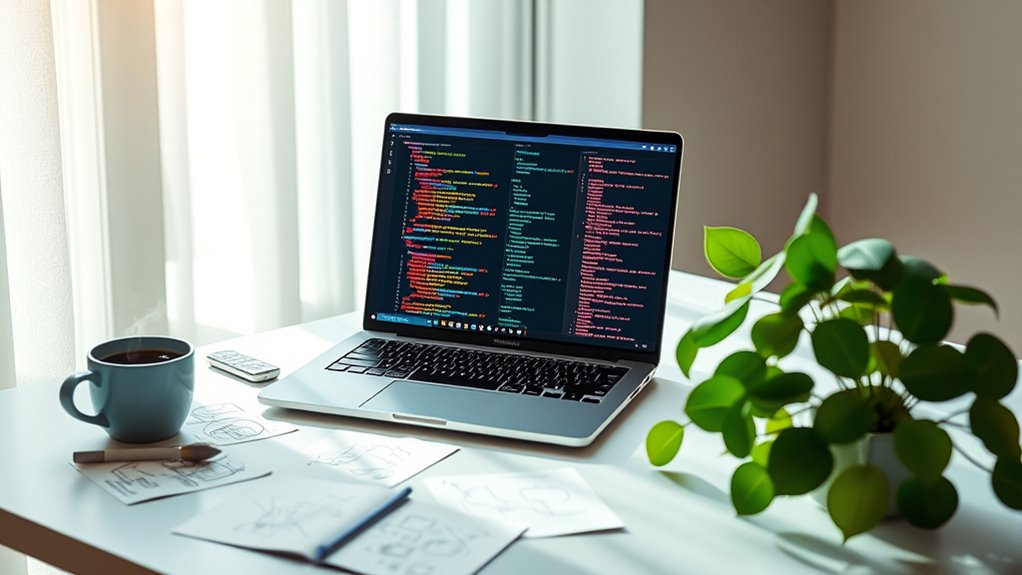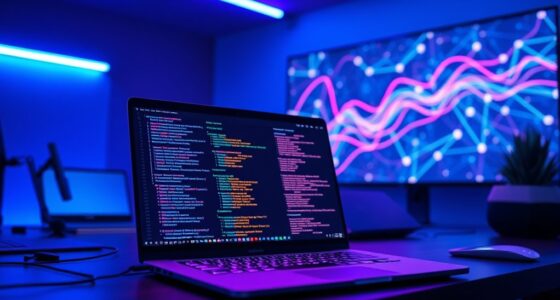Vibe coding is an AI-assisted approach to software development that lets you describe your software ideas in natural language. This method shifts your focus from manual coding to creativity, making it easier to prototype applications quickly. It’s perfect for non-programmers, allowing anyone to bring their ideas to life with an iterative process. However, it does come with some challenges, which you’ll explore as you learn more about this exciting technique and how to make it work for you.
Key Takeaways
- Vibe Coding is an AI-assisted method that transforms natural language descriptions into code, enhancing accessibility for non-programmers.
- It emphasizes rapid prototyping, allowing users to create software ideas in hours instead of days.
- The iterative process enables refinement of AI-generated code, fostering collaboration among users without coding skills.
- While user-friendly, Vibe Coding faces challenges like potential misunderstandings in complex requirements and debugging difficulties.
- Clear instructions and understanding core algorithms improve the accuracy and effectiveness of AI code generation.
Understanding Vibe Coding

As you plunge into vibe coding, you’ll discover it’s an AI-assisted approach that transforms how software is developed. Coined by Andrej Karpathy in February 2025, vibe coding lets you describe software requirements in natural language, while AI generates the necessary code. This method shifts your focus from manual coding to the creative aspects of development, enabling non-technical individuals to participate in app creation. With vibe coding, you can rapidly prototype ideas and enhance user experience without needing extensive programming skills. Additionally, this approach significantly lowers barriers to software creation, allowing for quick experimentation and user feedback.
How Vibe Coding Works

Vibe coding works by leveraging a prompt-driven approach that lets you articulate your software ideas in natural language. You start by describing your concept, and AI tools generate the corresponding code, minimizing manual coding efforts. This iterative process allows you to refine the AI-generated output through conversation, ensuring it aligns with your vision. You can quickly prototype features by focusing on software logic rather than syntax, making it accessible even for non-technical creators. Vibe coding facilitates quick prototyping of features, enabling you to explore your ideas more freely. Choose an appropriate AI platform, describe your idea, review the generated code, and engage in dialogue to enhance it. Finally, you can deploy and share your creation, bringing your software concept to life efficiently.
Benefits of Vibe Coding

While traditional coding can be intimidating for many, vibe coding opens up new avenues for software development by providing a user-friendly, natural language interface. This approach boosts speed and productivity, allowing you to create prototypes in hours instead of weeks. With a lower barrier to entry, anyone—including non-programmers—can bring their ideas to life. You’ll enjoy efficient prototyping, enabling rapid iteration and improved user experiences. Vibe coding fosters collaboration, letting domain experts contribute directly without coding skills. This not only optimizes resource use but also reduces project costs and maintenance efforts. Ultimately, vibe coding accelerates innovation, giving you a competitive edge and the ability to quickly validate ideas, making software development more accessible and effective. AI acts as a co-developer in this process, enhancing the overall experience for users. Additionally, this collaborative approach aligns with networking seen as essential for business expansion, allowing for diverse inputs that can lead to better outcomes. Furthermore, by leveraging data analytics for targeted advertising, vibe coding can help businesses better understand their market and reach their audience effectively.
Challenges in Vibe Coding

Although vibe coding offers exciting opportunities, it also comes with its share of challenges that can hinder its adoption and effectiveness. You might find that AI struggles with complex requirements, leading to misunderstandings and subpar results. Relying on AI-generated code raises concerns about security vulnerabilities and overall code quality. If you depend too much on these tools, you could face inefficiencies when they fail or become unavailable. Debugging AI code can also prove difficult, especially if you’re not familiar with it. Additionally, as the landscape of coding evolves, your traditional skills may risk obsolescence, making it essential to adapt to new standards and maintain creativity within your projects. Vibe coding emphasizes creativity and AI tools, which can sometimes lead to challenges in achieving polished results.
Techniques and Tools for Vibe Coding

To effectively navigate the world of vibe coding, it’s essential to employ specific techniques and utilize the right tools. Start with clear instructions; detailed descriptions help AI tools generate accurate code. Embrace iterative development by testing initial outputs and refining your requests based on results. Maintain a conversational flow with AI to collaboratively describe your software ideas and make adjustments. Rapid prototyping allows you to create quick models, while a feedback loop guarantees continuous improvement with visual insights. For tools, consider AI platforms like Refact.ai, advanced models for planning and execution, and versatile code editors like VS Code. Using visual tools can enhance your interaction with generated code, making the vibe coding process smoother and more efficient. Additionally, understanding core algorithms is crucial for effective communication with AI during the vibe coding process. The importance of color accuracy can also enhance the visual aspects of your software, similar to how it improves projector image quality.
The Future of Vibe Coding

As the landscape of software development evolves, vibe coding is set to revolutionize how we create applications.
You’ll find increased accessibility, allowing non-developers to easily participate in software creation, breaking down technical barriers. This democratization fosters collaboration across various fields, enriching innovation. With AI-powered development tools, expect faster development cycles, where prototypes come to life quickly, enabling rapid iteration and reduced costs. Your applications will adapt dynamically to user preferences, enhancing engagement through hyper-personalization.
Moreover, modern coding and debugging processes will leverage AI, minimizing errors and streamlining continuous integration. This shift accelerates digital transformation, pushing businesses to embrace AI-driven workflows.
Embracing vibe coding means you’re stepping into a future where creativity meets technology, transforming how we build and interact with software.
Frequently Asked Questions
Can Vibe Coding Replace Traditional Programming Entirely?
While vibe coding can considerably speed up development, it won’t entirely replace traditional programming.
Around 70% of software development still relies on manual coding for complex systems.
You’ll find that vibe coding excels in rapid prototyping and empowering non-programmers, but it struggles with intricate applications that need deep customization.
Trusting AI-generated code without review can lead to errors, making human oversight essential in many cases.
What Programming Languages Are Compatible With Vibe Coding?
When you’re diving into vibe coding, you’ll find it’s compatible with a variety of programming languages, thanks to its AI-driven nature.
Languages like Python and C are commonly used due to their robust libraries and support in AI applications.
Since the AI system adapts to your prompts, you can experiment with different languages as you see fit.
As AI models evolve, expect even more languages to join the compatibility list.
How Does Vibe Coding Handle Debugging and Error-Checking?
Imagine sailing a ship through stormy seas, where each wave represents a potential error.
To navigate these waters, you rely on your crew—AI tools that assist in debugging. You refine your prompts like adjusting sails, ensuring they catch the right winds.
With print statements and logs as your compass, you chart a course, testing continuously to avoid hidden reefs.
Is Vibe Coding Suitable for Large-Scale Software Projects?
Vibe coding can be suitable for large-scale software projects, but it comes with challenges.
You’ll need to guarantee consistency and quality across AI-generated code, which can vary. Effective collaboration is essential, as team members must communicate well to maintain standards.
While vibe coding allows for rapid prototyping and AI-assisted refining, be prepared to adapt your skills and implement robust code management strategies to navigate the complexities of larger projects successfully.
What Are the Best Resources to Learn Vibe Coding?
Did you know that over 70% of developers find AI tools enhance their coding efficiency?
To learn vibe coding, immerse yourself in Andrew Ng’s “Vibe Coding 101” on Replit for structured guidance.
YouTube offers a wealth of beginner-friendly tutorials, while platforms like SoftwareComposer connect you with like-minded learners.
Don’t forget to explore tools like Cursor and Chad GBT to practice your skills hands-on.
Engaging with these resources will elevate your coding journey!
Conclusion
In the world of coding, vibe coding stands out, blending creativity with logic. You can harness its unique energy to create something extraordinary or feel overwhelmed by its nuances. Embrace the balance between structure and spontaneity, and you’ll discover a powerful tool for self-expression. As you immerse yourself in vibe coding, remember that every challenge presents an opportunity to grow. With the right mindset and tools, you can shape your coding journey into something truly vibrant and impactful.









